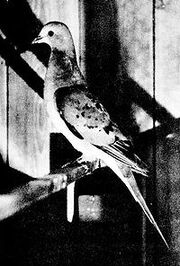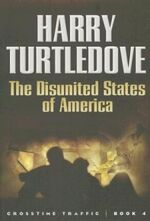
The passenger pigeon (Ectopistes migratorius) or wild pigeon was a species of pigeon that was once common in North America. It lived in enormous migratory flocks - sometimes containing more than two billion birds - that could stretch one mile (1.6 km) wide and 300 miles (500 km) long across the sky, sometimes taking several hours to pass.
Some estimate that there were three billion to five billion passenger pigeons in the United States when Europeans arrived in North America. The species went from being one of the most abundant birds in the world during the 19th century to extinction early in the 20th century. At the time, passenger pigeons had one of the largest groups or flocks of any animal, second only to the Rocky Mountain locust.
Some reduction in numbers occurred because of habitat loss when the Europeans started settling further inland. The primary factor emerged when pigeon meat was commercialized as a cheap food for slaves and the poor in the 19th century, resulting in hunting on a massive scale. There was a slow decline in their numbers between about 1800 and 1870, followed by a catastrophic decline between 1870 and 1890. Martha, thought to be the world's last passenger pigeon, died on September 1, 1914, in Cincinnati, Ohio.
Passenger pigeon in "Birdwitching"[]
A small flock of passenger pigeons was one of the species of birds that Lucy Parker magicked to Sunset Grove during a Yule Bird Count competition with Fred O'Neill. Up until that point, both witches had attracted birds through space only which took relatively little magic. But when O'Neill reached through both time and space to attract a Carolina Parakeet, Parker decided to match him and performed the same, more difficult feat.
Passenger pigeon in Crosstime Traffic[]
In Crosstime-accessible alternates where humans never evolved, the passenger pigeon was never threatened, and could be seen by Crosstime employees who cared to go birding, such as Lonnie.[1] They could also be seen in other alternates, where humans existed but had managed to refrain from doing as much ecological damage as in the home timeline, whether because they never had the power to do so, or practiced moderation in it.
Passenger pigeon in The Disunited States of America[]
The passenger pigeon was saved from extinction at the turn of the 20th century, when several North American nation-states passed laws that banned hunting it. By 2097, the species survived.[2]
Passenger pigeon in In High Places[]
In the alternate where the Great Black Deaths happened, passenger pigeons "still flew by the billion"[3] in North America in 2096. In the home timeline, the last known specimen had died 182 years earlier.
Passenger pigeon in Southern Victory[]
By the time of the Second Mexican War, the numbers of passenger pigeons had significantly declined. However, flocks were still large enough for General Orlando Willcox to have them served in the field for dinner for his staff and guests.[4]
The last known passenger pigeon was killed in the Cincinnati Zoo early in the Great War when the city was shelled by the Confederates.[5]
References[]
- ↑ The Disunited States of America, p. 280-281
- ↑ Ibid., pg. 29.
- ↑ In High Places, p. 62.
- ↑ How Few Remain, pg. 400, mmp.
- ↑ The Grapple, pg. 115, tpb.,
| ||||||||
| |||||
| ||||||||||||||||
| ||||||||||||||||












